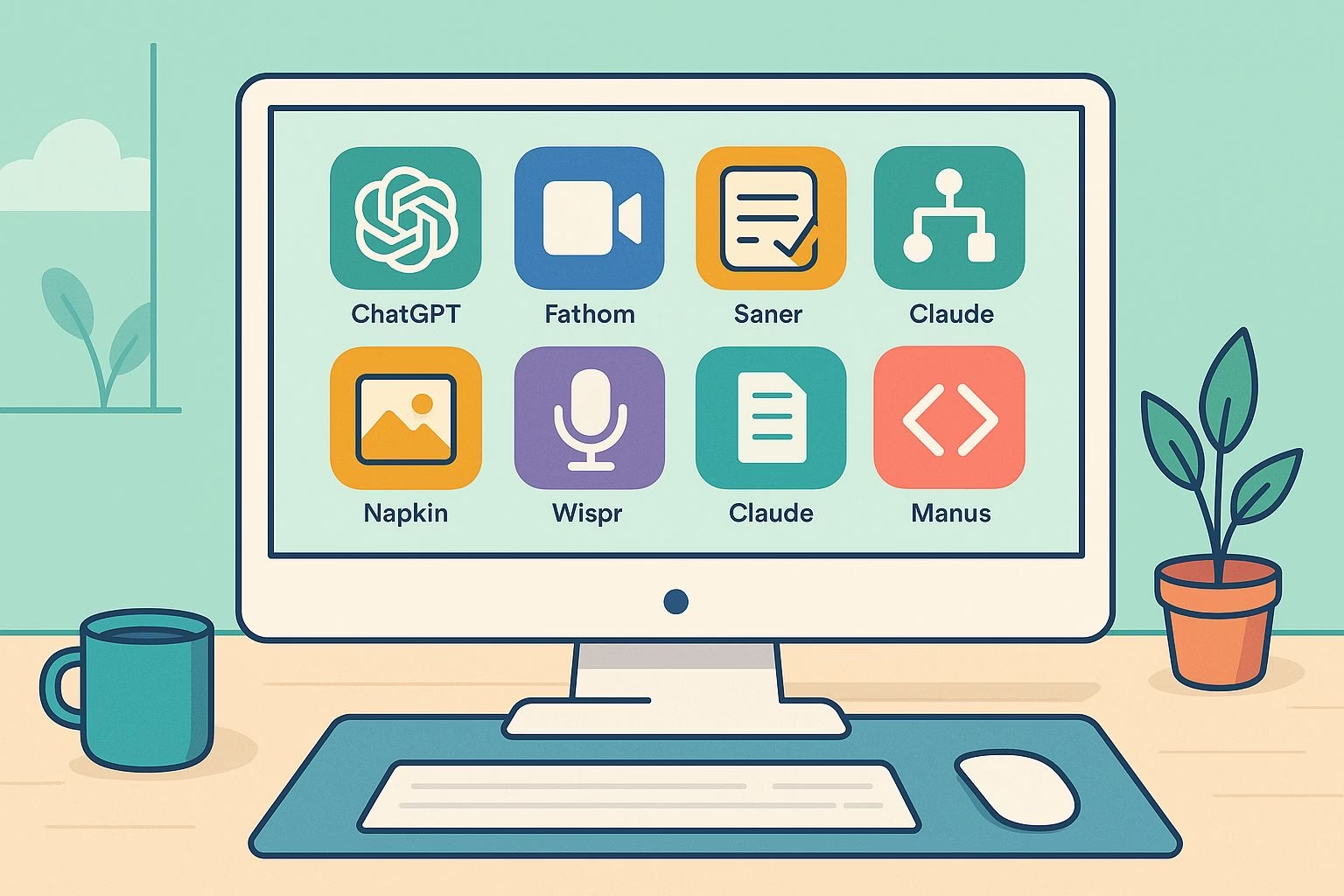12 Best AI Tools People Actually Use in 2026
Going into 2026, we have seen countless AI launches. Some get hyped for a week and vanish. Others stick because they solve real problems.
From browsing through what users actually rely on, a clear picture emerges:
the best AI tools are not the flashiest, but the ones that make daily life smoother.
I’ve pulled together the most mentioned tools, alongside how people are actually using them.
Going into 2026, the pattern is even clearer. People keep the tools that reduce admin work, capture decisions, and connect to the systems they already use.
Everything else turns into a tab you stop opening.
These are not just for testing on day one and forgetting. They’re in regular use for brainstorming, meetings, automation, and even bidding on home repairs.
The difference is clear when tools cross over from “interesting” to “indispensable.”
Want to know which ones deserve a spot in your workflow?
Let’s break it down with real-world usage examples.
PS: If your marketing feels stuck on manual mode, you might want to try Blaze Autopilot. It scans your website, learns your voice, and starts creating and posting content automatically, social posts, blogs, and newsletters that sound like you. Once set up, it runs hands-free while you focus on your business.
Productivity tools people swear by
The tools people stick with day after day are the ones that cut through noise and actually free up time.
They don’t just sound good on launch day; they earn a permanent place in workflows because they handle repetitive, draining tasks.
In 2025, the clear winners are tools that help manage information overload, organize thoughts, and automate routine processes.
Instead of juggling countless apps, many users are consolidating their work into fewer, smarter tools. These AI assistants capture meetings, track tasks, and highlight what you might be missing.
The impact is tangible: less time wasted on admin, more space for decision-making.
Here are the top ones that keep showing up:
-
ChatGPT
Still the most mentioned, ChatGPT is used for brainstorming campaigns, creating content drafts, and even planning lessons. A marketer, for instance, can input a product description and get three ad headline options in seconds, then refine with feedback until it’s campaign-ready. Teachers use it to build study guides from scratch, cutting prep time by half. -
Fathom
Popular for meeting management, Fathom records conversations, produces transcripts, and generates action lists automatically. Imagine wrapping up a one-hour project meeting and instantly having a clean summary to send to your team. Instead of wasting time taking notes, you stay engaged in the conversation while the AI does the admin work. -
Saner
This tool acts like a proactive assistant. Beyond storing notes and tasks, it points out things you may be forgetting. Planning a conference? Saner might remind you about travel bookings when you only logged catering and schedules. That extra layer of guidance helps avoid mistakes that come from being too close to your own plans.
In 2026, the tools that survive are the ones that reduce context switching and turn conversations into next steps.
Creative tools gaining traction
On the creative side, AI tools are becoming the shortcut between ideas and polished output. Instead of waiting for inspiration or spending hours in design software, users are letting AI handle the heavy lifting.
These tools fit well into workflows where speed and clarity matter more than perfect design.
People are increasingly using AI to capture ideas on the go and turn them into something tangible.
Whether that’s slides for a client pitch, transcriptions of voice notes, or even structured data analysis, creative tools are breaking down barriers between raw thought and presentation-ready material.
Here are the standouts that people keep returning to:
-
Napkin
Known for turning text into visuals, Napkin helps users create simple graphics for presentations. For example, instead of designing a chart from scratch, you can paste bullet points into Napkin and get an illustrated slide that’s clear enough for a meeting. It doesn’t replace a designer, but it saves hours when visuals are needed fast. -
Wispr
Designed for voice-to-text, Wispr is a favorite among people who think faster than they can type. Picture a founder on a walk capturing a five-minute voice note full of scattered ideas. With Wispr, that ramble turns into a structured transcript ready to paste into a doc, email, or Trello board. It keeps creativity moving without bottlenecks. -
Claude for structured projects
A striking example came from someone who fed Claude a messy home inspection report. The AI broke it into categories, researched repair costs in the local market, built a Google Sheet with formulas, and drafted emails to contractors. A process that would normally take hours of manual data entry, research, and writing was condensed into 30 minutes. That’s a clear sign of AI moving beyond creativity into execution.
Emerging agent workflows
If 2023 was about simple chatbots, 2025 is about agents that can actually take action.
These are not just text generators; they connect with other apps, pull live data, and even rearrange tasks in your calendar.
People are excited about them because they close the gap between asking for something and having it done.
The strongest examples come from setups where AI doesn’t just answer but interacts with tools like Google Docs, Gmail, or project boards.
Instead of copying outputs from one tool into another, you set up workflows where the AI talks directly to your systems.
That saves hours of repetitive work and lets you stay focused on decisions instead of logistics.
-
Claude with Zapier
One user described connecting Claude through Zapier to their email, Google Docs, and spreadsheets. When given a home inspection report, Claude categorized the issues, researched local repair costs, built a formula-packed spreadsheet, and drafted emails to contractors. What used to be a full afternoon of back-and-forth became a 30-minute workflow with almost no manual input. -
Gemini in STT agents
Gemini is also being used as a backbone for speech-to-text agents. For instance, one user built an AI receptionist by combining Gemini’s transcription with an open-source workflow builder. The agent not only transcribes calls but also routes information, schedules follow-ups, and provides real-time responses. That’s the kind of integration where AI begins to feel less like a tool and more like a team member. -
Dograh AI workflow builder
This open-source option gives people the flexibility to design custom automation. A sales team example stood out: they used Dograh to build an AI-driven sales automation platform that combined conversation handling with data syncing. The result was a scalable process that didn’t rely on patching together multiple SaaS apps.
Specialty tools for niche needs
Beyond the mainstream names, smaller tools are carving out space by solving specific pain points.
These don’t always get the headlines, but for those who use them, they can be game changers.
What makes them stand out is how they slot into workflows where big players don’t fit. Some are built for coding, others for research, and some simply for consolidating chats into one space.
They may not replace ChatGPT or Gemini, but they fill gaps in ways that feel surprisingly valuable.
-
NotebookLM
Popular for research and study, NotebookLM shines because it stays grounded in sources. Unlike older tools that hallucinated when PDFs were uploaded, NotebookLM lets you query documents while keeping references visible. For students or professionals reviewing long reports, it becomes a trustworthy sidekick for pulling accurate information. -
Manus
This one is saving time across both personal and professional work. People mention using Manus for heavy writing tasks, data processing, and even drafting longer content pieces. For someone balancing client reports with side projects, Manus acts like a background engine that handles grunt work reliably. -
Geekflare Connect
Designed to consolidate multiple AI chats, Geekflare Connect keeps conversations organized in one hub. Instead of switching tabs between ChatGPT, Claude, and others, you can manage everything in a single interface. This is especially helpful for people experimenting with different models daily but wanting to keep a clean history.
Quick recap of the best AI tools people are using in 2026:
- ChatGPT – brainstorming, content creation, lesson planning
- Fathom – automatic meeting transcripts and action items
- Saner – proactive reminders for notes, tasks, and schedules
- Napkin – text to simple presentation visuals
- Wispr – capture and transcribe voice notes instantly
- Claude – advanced projects with Zapier integrations
- Gemini – STT-based agents and automation
- Dograh AI – open-source workflow building
- NotebookLM – accurate document-based research
- Manus – heavy lifting for writing and data processing
- Geekflare Connect – all AI chats in one place
Final thoughts
Nine months into 2025, the hype around new AI apps hasn’t slowed down, but only a handful have proven they’re worth keeping.
From productivity boosters like ChatGPT, Fathom, and Saner to creative helpers like Napkin and Wispr, people are leaning on AI for more than experiments; they’re building daily habits around it.
The rise of agent workflows shows where the real shift is happening. Connecting Claude to Zapier or using Gemini in STT agents isn’t just about generating text.
It’s about AI stepping into operations, doing the busywork, and freeing people to make decisions faster.
Niche tools like NotebookLM, Manus, and Geekflare Connect round out the picture by solving very specific needs that bigger players overlook.
What’s clear is that the AI tools that last are the ones that solve everyday pain points. They make meetings less of a chore, notes easier to manage, and complex projects faster to execute.
Everything else is just noise that fades as quickly as it arrived.

